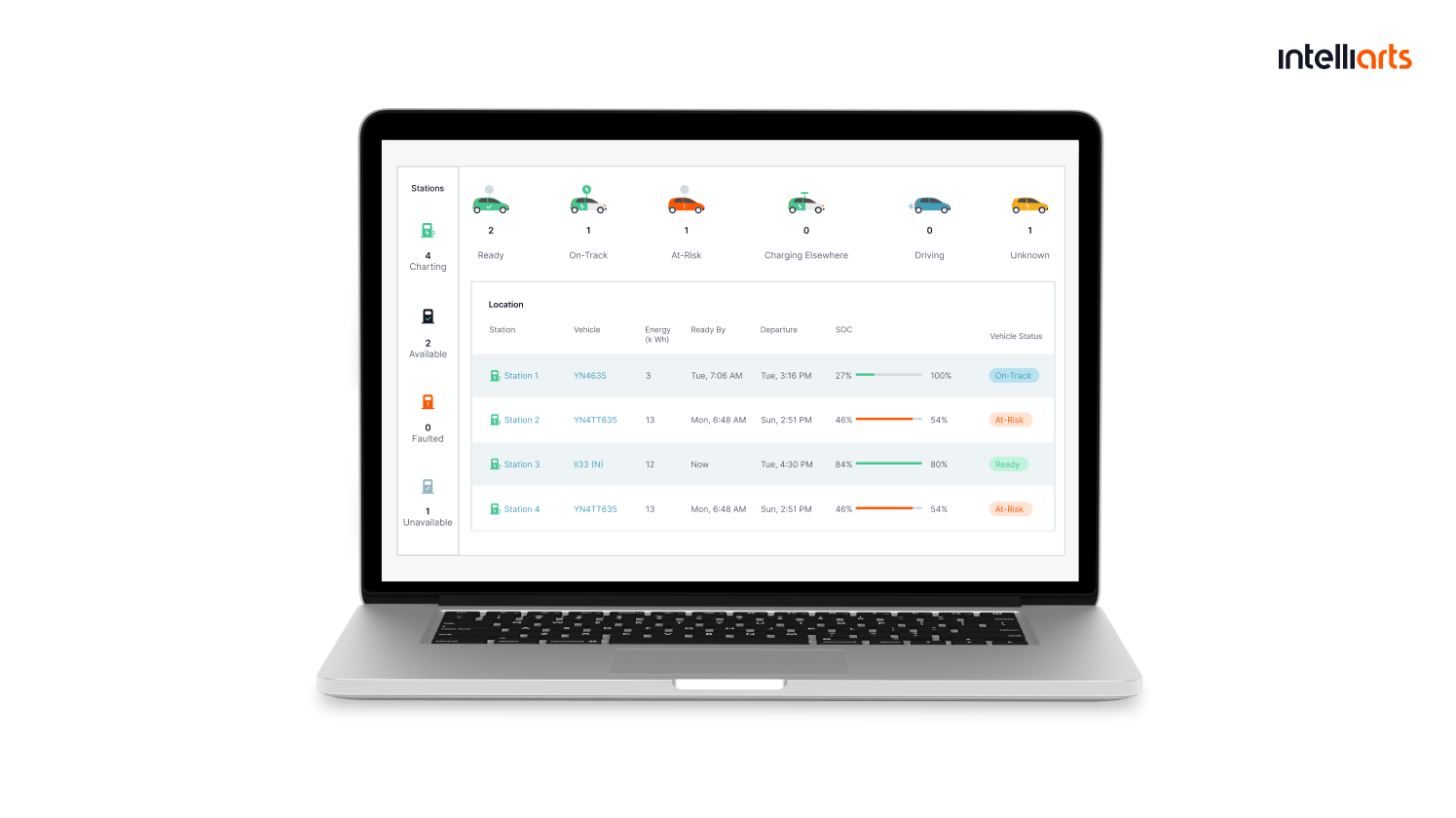The usage of vehicles in business has grown over time due to an increasing number of logistics, energy, manufacturing, and other companies. But what’s the biggest challenge in owning fleets of vehicles? The answer is effective management. From sustainable energy usage to incorporating smart communication measures in vehicles — fleet management can cover all that and more.
In this post, you’ll explore the 8 biggest fleet management trends, discover how the industry may evolve over time, and review real-life fleet management success stories, drawn from our 8 years of experience in creating EV solutions.
8 Trends in fleet management technology for 2025
The way companies operate with their fleets has substantially evolved over the past several decades. It brings us to the necessity to explore fleet management trends in great detail to find areas for improvement and ways to incorporate technology in business.
#1 Incorporation of AI in fleet management
AI is transforming fleet management technology trends by automating decision-making, optimizing routes, enhancing predictive maintenance, and improving driver safety. AI-powered analytics help fleets reduce fuel consumption, prevent breakdowns, and comply with regulations.
A report by Allied Market Research shows that the global automotive artificial intelligence market is projected to reach $405.3 billion by 2032, growing at a CAGR of 40.7% from 2023 to 2032. This suggests that AI-driven automation is becoming essential as fleets scale operations and seek cost savings.
Business issues this technology addresses:
- Inefficient route planning that leads to higher fuel costs
- Unplanned vehicle breakdowns causing operational delays
- Inconsistent driver behavior impacting safety and compliance
- Data overload without actionable insights
- Rising operational costs due to manual decision-making
Solutions in the market:
- Lytx DriveCam — AI-powered fleet safety and telematics
- Geotab AI Insights — AI-driven fleet optimization tools
- Fleet Complete — AI-enabled vehicle tracking and diagnostics
- Omnitracs — AI-powered predictive maintenance and routing
#2 Advancing telematics solutions for fleets
Telematics technology is evolving beyond basic GPS tracking to offer real-time diagnostics, driver behavior analytics, fuel efficiency monitoring, and AI-powered predictive maintenance. With the rise of IoT, 5G connectivity, and cloud computing, fleet operators can gain deeper insights into vehicle performance, reduce costs, and improve safety.
According to the Markets and Markets report, the global telematics market is expected to reach $9.0 billion, growing at a CAGR of 10.1%.
Business issues this technology addresses:
- Lack of real-time visibility into fleet operations
- High fuel consumption and operational costs
- Inefficient maintenance scheduling leading to vehicle downtime
- Safety concerns due to poor driver behavior
- Compliance challenges with government regulations (e.g., ELD mandates)
Solutions in the market:
- Geotab — Fleet telematics and tracking solutions
- Samsara — AI-driven telematics platform with video safety features
- Verizon Connect — GPS fleet tracking and compliance solutions
- Teletrac Navman — Fleet management and ELD compliance tools
#3 Green fleet initiatives
Sustainability is becoming a priority in fleet management industry trends, with companies adopting green fleet initiatives to reduce carbon footprints, comply with environmental regulations, and lower fuel costs. Strategies include using alternative fuels, optimizing routes to minimize emissions, and incorporating electric and hybrid vehicles.
According to the International Energy Agency (IEA), electric vehicle (EV) sales are expected to reach 45% of total vehicle sales by 2030, driving a shift toward greener fleet operations.
Business issues this technology addresses:
- Rising fuel costs and dependency on fossil fuels
- Stricter government emissions regulations
- Corporate sustainability and ESG (Environmental, Social, and Governance) requirements
- Limited infrastructure for alternative fuels
- Balancing cost-effectiveness with environmental goals
Solutions in the market:
- ChargePoint — EV charging solutions for fleets
- Geotab Sustainability — Fleet carbon footprint tracking
- Shell Fleet Solutions — Alternative fuel options and carbon offset programs
- Tesla Semi — Electric trucks for sustainable fleet management
Explore how IoT can boost renewable energy initiatives from another post written by Intelliarts experts.
#4 Gradual vehicle electrification
The shift toward electric vehicles (EVs) in fleets is accelerating due to lower operating costs, government incentives, and advancements in battery technology. While full electrification is still in progress, many companies are integrating EVs gradually to balance cost and infrastructure readiness.
The global electric vehicle market is projected to reach $823.75 billion by 2030, growing at a CAGR of 18.2% from 2021 to 2030. This trend is signaling a major shift in fleet management market trends toward sustainability and efficiency.
Business issues this technology addresses:
- High initial investment in EVs and charging infrastructure
- Limited charging stations affecting fleet operations
- Battery range concerns for long-haul routes
- Uncertainty around total cost of ownership compared to fuel-powered vehicles
- Integration challenges with existing fleet management systems
Solutions in the market:
- Intelliarts — Predictive maintenance solution for EV chargers
- GM BrightDrop — Electric delivery vans for fleet operations
- ABB E-Mobility — EV charging infrastructure for fleets
You may be curious to explore how to track and streamline your EV fleet, which is well-detailed by an Intelliarts expert in our corresponding blog post.
#5 IoT and connected vehicles
The integration of Internet of Things (IoT) technology in fleet management is revolutionizing real-time tracking, predictive maintenance, and driver safety. Connected vehicles use sensors, cloud computing, and AI to optimize fleet performance, reduce downtime, and enhance operational efficiency.
According to Allied Market Research, the global IoT in transportation market is expected to reach $495.57 billion by 2030, reflecting its impact on fleet management tech trends.
Business issues this technology addresses:
- Limited real-time visibility into vehicle health and location
- Unplanned vehicle breakdowns leading to costly downtime
- Inefficiencies in fuel consumption and route optimization
- Lack of proactive safety measures for drivers
- Compliance challenges with regulatory reporting
Solutions in the market:
- Intelliarts — EV fleet management software
- Samsara Connected Operations — IoT-powered telematics and fleet analytics
- Geotab IoT Solutions — Vehicle tracking and predictive maintenance
- Verizon Connect Reveal — Connected fleet monitoring and insights
- Teletrac Navman — IoT-enabled fleet intelligence platform
#6 Digital twins for fleet optimization
Digital twin technology is reshaping fleet management technology trends by creating real-time virtual models of fleet operations. These models simulate vehicle performance, predict maintenance needs, and optimize logistics to reduce costs and downtime. By leveraging AI and IoT data, fleet managers can test scenarios and improve efficiency before making real-world changes.
According to Gartner, by 2027, over 75% of large enterprises will use digital twins to improve operations and asset management.
Business issues this technology addresses:
- Difficulty in predicting vehicle failures and maintenance needs
- Inefficiencies in fleet route planning and fuel usage
- High costs of unexpected breakdowns and operational disruptions
- Lack of real-time insights into vehicle and driver performance
- Challenges in optimizing asset utilization across a fleet
Solutions in the market:
- PTC ThingWorx — Digital twin platform for industrial and fleet operations
- Siemens Digital Twin — Fleet simulation and predictive analytics
- Microsoft Azure Digital Twins — Cloud-based digital twin solutions
- Bosch Digital Twin — IoT-powered fleet performance modeling
“It’s easy to observe how digital twins transform from an experimental gimmick into technology for everyday usage.” — Volodymyr Mudryi, an AI and ML engineer at Intelliarts.
#7 Integration of V2X (vehicle-to-everything) communication
V2X communication is a game-changer in trends in fleet management technology, enabling real-time data exchange between vehicles, infrastructure, pedestrians, and networks. This technology enhances safety, reduces traffic congestion, and improves fuel efficiency by allowing vehicles to anticipate road conditions.
The global automotive V2X market is projected to grow from $0.5 billion in 2023 to $9.5 billion by 2030, at a CAGR of 51.9%. Presumably, it’s driven by the rise of smart cities and autonomous driving solutions.
Business issues this technology addresses:
- Limited real-time awareness of road hazards and traffic conditions
- Increased fuel consumption due to inefficient route adjustments
- High accident rates due to lack of vehicle-to-vehicle communication
- Challenges in coordinating fleet movements in urban environments
- Regulatory pressure to improve road safety and emissions
Explore how V2X works on use case examples in the video below:
Solutions in the market:
- Autotalks — V2X chipsets for connected vehicle communication
- Qualcomm C-V2X — Cellular V2X technology for fleet safety
- Cohda Wireless — V2X solutions for fleet management
- Savari V2X — Smart transportation and connected vehicle solutions
You may additionally be interested in exploring use cases of ML in the manufacturing in another blog post by Intelliarts.
#8 Enhanced driver safety monitoring systems
Driver safety monitoring systems are a crucial part of fleet management trends in 2024, leveraging AI, telematics, and biometrics to detect fatigue, distraction, and unsafe driving behaviors. These systems help fleet managers reduce accidents, lower insurance costs, and comply with safety regulations.
According to the National Highway Traffic Safety Administration (NHTSA), drowsy driving causes over 100,000 crashes annually in the U.S. only. This fact emphasizes the need for advanced monitoring solutions.
Business issues this technology addresses:
- High accident rates due to driver fatigue and distraction
- Rising insurance premiums linked to unsafe driving behavior
- Limited real-time monitoring of driver activity
- Compliance challenges with safety regulations
- Difficulty in providing immediate feedback and coaching to drivers
Solutions in the market:
- Samsara AI Dash Cams — Real-time driver safety monitoring
- Nauto – AI-driven driver behavior monitoring
- Omnitracs Critical Event Video — Fleet safety and event recording
- SmartDrive — Video-based driver safety coaching
What’s also interesting is that the trends we can observe in the present day, are likely to be preconditions for future changes.
Future outlook and predictions
Now, let’s take a closer look at how the listed fleet management trends may evolve over time and what assumptions for the future we can make today:
#1 EV adoption will accelerate, limited only by infrastructure shortages
The global push for sustainable fleets will intensify, with governments and corporations prioritizing EV adoption. However, infrastructure gaps, such as charging station availability and battery performance limitations, will remain obstacles.
Prediction: By 2030, over 50% of new commercial fleet vehicle purchases will be electric.
Recommendation from our tech lead: It’s best for fleet managers to develop phased EV adoption strategies and invest in private charging infrastructure to mitigate range limitations.
#2 Sustainability regulations will push green fleet initiatives forward
Global sustainability regulations will become more stringent, compelling fleet operators to adopt greener practices. Carbon emissions tracking, alternative fuels, and EV integration will become regulatory requirements rather than voluntary initiatives.
Prediction: The global carbon footprint management market is projected to reach $14.74 billion by 2028.
Recommendation from our PM: It’s worth for companies should proactively adopt sustainability-focused fleet management strategies, including carbon tracking software, alternative fuels, and efficient route optimization.
#3 Fleet management software will become fully cloud-native and AI-driven
It’s likely that cloud-based fleet management platforms will become the industry standard, integrating real-time data, AI-driven analytics, and automated decision-making processes.
Prediction: By 2027, it’s forecasted that nearly half of all Industrial IoT (IIoT) applications will incorporate AI elements.
Recommendation from our partner: Fleet operators should shift to cloud-based fleet management solutions to improve scalability, enable real-time data analysis, and enhance overall operational efficiency.
Intelliarts experience
Here are two out of the many success stories by Intelliarts, describing our experience with EV, IoT, and fleet management technologies:
Next-Gen EV Fleet Management Software Development
Challenge:
A major EV charging provider — EV Connect, sought to expand into fleet management, enabling operators to monitor vehicles, optimize charging schedules, and reduce costs. The company required a solution that could support depot, on-route, and at-home charging while ensuring energy efficiency.
Solution:
Intelliarts developed an advanced EV fleet management system that allowed fleet operators to track vehicle statuses, manage charging infrastructure, and optimize energy consumption. The platform integrated telematics solutions such as Geotab and NFI Connect for precise vehicle tracking, energy use monitoring, and smart charging prioritization based on real-time data.
Results:
The solution improved operational efficiency by enabling real-time station monitoring and automated charge scheduling. It reduced fleet downtime and energy costs through predictive analytics, smart load management, and optimized charging decisions. Fleet operators gained better control over expenses and fleet performance, enhancing overall business sustainability.
Predictive Maintenance Solution for EV Chargers
Challenge:
EV Connect, a leading provider of EV charging solutions, needed to enhance the reliability of its charging stations by reducing unexpected failures and minimizing downtime. The company sought a predictive maintenance (PdM) system capable of analyzing equipment behavior, detecting anomalies, and optimizing maintenance schedules based on real-time data.
Solution:
Intelliarts conducted a detailed data analysis to prepare EV Connect for implementing a PdM system. The project involved transforming raw data from log records into structured formats, performing anomaly detection to identify early failure indicators, and analyzing historical data to uncover usage patterns.
Results:
Intelliarts provided actionable insights on EV charger behavior, improving system reliability and maintenance efficiency. The company gained a better understanding of failure patterns, allowing for proactive maintenance planning. Additionally, Intelliarts’ data quality recommendations helped EV Connect refine its PdM model, optimizing tariff adjustments, system performance, and overall customer experience.
Final take
The future of fleet management is shaped by AI, IoT, and sustainability-driven innovations. As automation advances, fleets will operate with greater efficiency, reduced costs, and improved safety. The shift toward electric and connected vehicles will accelerate, with cloud-native platforms enabling real-time data-driven decision-making. Companies that embrace these technologies early will gain a competitive edge.
Should you need assistance with applying technology solutions to solve fleet management difficulties in your business, consider partnering with a trusted software company. Here at Intelliarts, with more than 24 years of experience in the market, we are ready, willing, and able to contribute to your best project with our expertise.
FAQ
1. What challenges are associated with adopting technologies in fleet management operations?
Integrating new fleet management technology trends requires overcoming high implementation costs, system compatibility issues, and resistance from employees. Companies must ensure proper training, data security, and compliance with regulations. Additionally, managing real-time data and integrating AI-driven insights pose challenges, especially for businesses with legacy systems. Partnering with a business technology consulting firm can help address these challenges effectively and ensure a smoother digital transition.
2. What is the role of technology in fleet management system?
Technology plays a vital role in modern fleet management by providing real-time tracking, route optimization, and maintenance. It enables scheduling, fuel monitoring, and cost reduction while enhancing safety and compliance. Advanced tools including GPS, IoT sensors, and data analytics empower fleet managers with actionable insights for improved decision making efficiently.
3. Which software is used for fleet management?
Fleet management software solutions such as Fleet Complete, Samsara, and Geotab are widely used to optimize vehicle operations. These platforms offer real-time GPS tracking, route planning, fuel consumption monitoring, and maintenance scheduling. They integrate IoT devices and cloud analytics to enhance efficiency, reduce costs, and improve overall fleet performance seamlessly.














